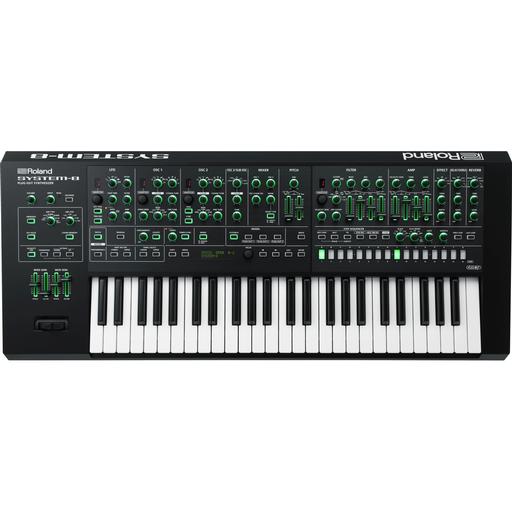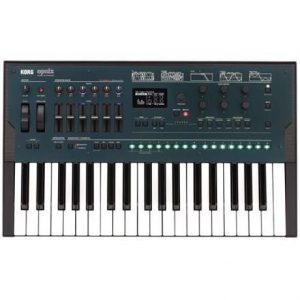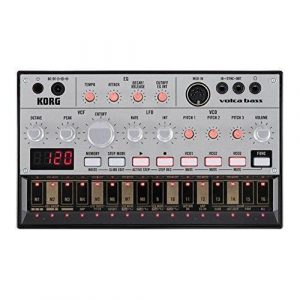Roland System-8
$1,116.99
Experience the ultimate in sound design with the Roland System-8, a highly advanced synthesizer that delivers the latest synthesis technology and sound library.
Compare
Description
The Roland System-8 Synthesizer is a powerful, modern synthesizer that offers a wide range of sounds and advanced features that cater to the needs of both professional and novice musicians. This synthesizer has gained popularity among musicians of all genres for its exceptional sound quality and versatility.
At first glance, the System-8 Synthesizer has an attractive and elegant design with a sleek black finish. It features a 49-note keyboard with velocity and aftertouch sensitivity, which provides an expressive playing experience. The keyboard is also multi-touch capable, allowing for more dynamic control and performance.
One of the most impressive features of the System-8 Synthesizer is its sound engine. With an eight-voice polyphony, it can produce a wide range of sounds, from classic retro sounds to modern electronic music. This synthesizer has three oscillators per voice, which can be configured in various modes, including the famous Supersaw mode, which generates huge, thick sounds.
The System-8 Synthesizer also features a modern filter section that offers a variety of filter types, including low-pass, high-pass, band-pass, and a combination of all three. The filter section also includes a resonance control and an envelope generator, which adds character and depth to the sounds.
In addition to the impressive sound engine, the System-8 Synthesizer offers other advanced features that make it a desirable instrument for professionals. The synth has a built-in arpeggiator, chord memory, step sequencer, and a multi-effect section, which allows for the creation of complex, layered sounds and patterns.
The System-8 Synthesizer also has the capability of expanding its sound library with the use of its three expansion slots. These expansion slots can host different types of sound cartridges, including the PLUG-OUT series, which allows musicians to access Roland’s library of classic synthesizer sounds. This feature makes the System-8 Synthesizer a versatile tool for music production and performance.
In conclusion, the Roland System-8 Synthesizer is an excellent modern synthesizer that offers a wide range of sounds, advanced features, and exceptional sound quality. Its sleek design, multi-touch keyboard, and expandable sound library make it an attractive choice for both professional and novice musicians who are looking for a high-quality instrument that can take their music production and performance to the next level.
Roland System-8 properties
| Product name |
Roland System-8 |
| Brand |
Roland |
| Type |
Synthesizers |
| Drawbars/Sliders |
Yes |
| Pads |
Yes |
| Rotary Controls |
Yes |
| Colour |
Black |
Frequently Asked Questions:
How does the Roland System-8's Super NES sound source differ from the original Super NES chip used in classic gaming consoles?
The Roland System-8 synthesizer features a newly developed sound engine called the Super NES sound source, which is based on the original sound chip used in Nintendo's classic gaming console, the Super NES. However, the Roland version has been significantly enhanced to offer greater functionality and sonic flexibility. While the Super NES chip produced 14-bit resolution for each of its three channels, the System-8's Super NES sound source offers improved processing capabilities, including sample playback, bitcrushing, and ring modulation, that go beyond what was possible with the original hardware. This results in a much more versatile and modern sound that can be used in a variety of musical applications, beyond just classic gaming music.
What is the unique feature of the Roland System-8 that allows for seamless integration with vintage Roland instruments through its digital replication technology?
The Roland System-8's unique feature that allows for seamless integration with vintage Roland instruments through its digital replication technology is the use of Roland's SuperNATURAL synth and ACB (Acoustic Circuit Behavior) modeling. This technology allows the System-8 to accurately replicate the sound, behavior, and response of classic Roland synthesizers from the past, making it easy to incorporate vintage gear into modern setups without compromising on sound quality or compatibility.
How does the Roland System-8's SuperNATURAL technology enhance the sound quality and realism of its synthesized sounds?
The Roland System-8's SuperNATURAL technology is a sophisticated sound engine that utilizes advanced algorithms to create incredibly detailed and lifelike sounds. This technology goes beyond simple sampling by analyzing the characteristics of each instrument, such as the way it responds to touch, breath, and key pressure. The system then uses this information to synthesize a new, richer sound that accurately reflects the unique qualities of the original instrument. As a result, the System-8's synthesized sounds are incredibly realistic and expressive, allowing musicians to create truly authentic performances. Furthermore, SuperNATURAL technology enables the System-8 to produce a wide range of sounds beyond traditional instruments, such as complex textures, atmospheric pads, and evolving soundscapes, making it an incredibly versatile synthesizer for a variety of musical genres and applications. Overall, SuperNATURAL technology is a major factor in the System-8's exceptional sound quality and realism, making it a top choice for serious musicians seeking the highest level of performance and expression from their synthesizers.
What are the key features and capabilities of the Roland System-8, and how can it be optimized to deliver exceptional sound quality in a live performance setting?
The Roland System-8 is an advanced synthesizer workstation that combines classic Roland analog circuitry with cutting-edge digital technology. Some of its key features include:
1. Analog Synthesis: The System-8's core sound engine utilizes Roland's legendary analog filters and amplifiers to deliver rich, warm, and complex tones. Digital Oscillators: In addition to the analog section, the System-8 also features two digital oscillators that provide a wide range of modern synthesis options. Modulation Matrix: The System-8's flexible modulation matrix allows for deep, intricate sound design and animation capabilities. Effects Processing: Onboard effects include reverb, delay, chorus, flanger, and more, allowing for a wide variety of tonal options. Sequencer: The System-8's advanced sequencer features 16-step recording with real-time overdubbing, undo/redo functionality, and the ability to record automation data for parameters like filters, oscillators, and effects. To optimize the Roland System-8 for exceptional sound quality in a live performance setting, several strategies can be employed:
1. Patch Management: Careful consideration should be given to the selection and organization of patches to ensure that the most important and versatile sounds are easily accessible during a live performance. This may involve creating custom presets or using the System-8's performance mode feature to save groups of related patches for quick recall. MIDI Sync: The System-8 supports a variety of MIDI sync protocols, allowing it to easily integrate into an existing live setup. By synchronizing with other devices in the chain, such as drum machines and sequencers, the System-8 can be used to create cohesive and dynamic performances. Effects Utilization: The System-8's effects processing capabilities can be used to enhance and shape sounds in a live setting. By applying appropriate effects, such as reverb or delay, it's possible to create rich, immersive textures that will captivate the audience. Monitoring and Feedback: Careful consideration should be given to the System-8's output monitoring and feedback options to ensure that sound quality is maintained at high volumes. By using appropriate techniques, such as placing monitors in strategic locations or utilizing feedback loops, it's possible to deliver exceptional sound quality even in loud live environments. Performance Techniques: Finally, the System-8's advanced performance mode feature can be used to create dynamic and engaging live performances. By allowing for the creation of custom sets of patches and parameter values, it's possible to take full advantage of the System-8's capabilities and deliver truly exceptional sound quality in a live setting. By following these strategies, it's possible to maximize the Roland System-8's potential in a live performance context, delivering rich, complex, and engaging sounds that will captivate audiences and leave them wanting more.
Can you explain the difference between the System-8's Super Saw and its built-in digital oscillators, and how to effectively utilize each for unique tonal characteristics?
**
The Super Saw is an analog-style sawtooth oscillator with some clever digital enhancements. It's essentially a high-resolution digital-to-analog converter (DAC) that emulates the characteristics of an analog sawtooth wave. This means it has a more rounded, warm, and rich tone compared to traditional digital oscillators. Some key features of the Super Saw:
1. Analog-like behavior**: The Super Saw exhibits some of the same quirks as an analog sawtooth oscillator, such as subtle pitch variations due to thermal noise. High resolution**: With 256x oversampling, the Super Saw offers a much higher resolution than traditional digital oscillators. Built-in detuning**: Each voice in the Super Saw has its own detuning value, which can add complexity and interest to your sounds. Digital Oscillators:**
The System-8's built-in digital oscillators are based on 16-bit linear interpolation and offer a clean, accurate sound. These oscillators are great for creating bright, sharp tones with a wide range of timbres. Some key features of the digital oscillators:
1. Clean sound**: Digital oscillators produce a very clean, uncolored sound that's free from distortion or warmth. Wide range of timbres**: With 8 different waveforms and extensive modulation options, you can create an incredibly wide range of sounds with these oscillators. Comparison and Utilization:**
Now, let's talk about how to effectively utilize each for unique tonal characteristics:
1. Warmth vs. Brightness**: Use the Super Saw for warm, rich tones, while the digital oscillators are better suited for bright, sharp sounds. Analog-like behavior**: If you want a sound that exhibits some of the same quirks as an analog sawtooth oscillator, use the Super Saw with its detuning enabled. High resolution**: For precise control over your sound's timbre and texture, use the digital oscillators. Combining both**: Experiment with layering both types of oscillators to create complex, interesting sounds. Some specific scenarios where you might prefer one over the other:
* If you're creating a retro-style synth lead or pad, the Super Saw is an excellent choice for its warm, analog-like tone. For bright, percussive sounds like plucks or bells, the digital oscillators are a great option. When creating complex textures or ambient pads, layering both types of oscillators can create fascinating timbres.
Before you buy Roland System-8
 Korg microKORG
Korg microKORG 







Reviews
There are no reviews yet.